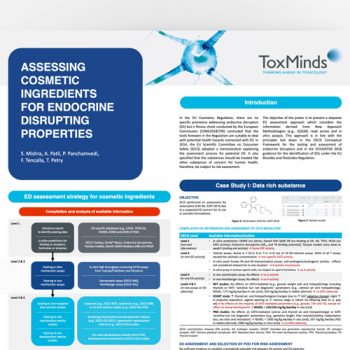
Advancing cosmetic safety: An industry case study using an NGRA framework to support the safety of daidzein in a cosmetic product
Najjar et al. (2024) recently proposed an interesting 10-step approach to determine a safe use concentration of daidzein, a soy isoflavone, in body lotions. The proposed framework illustrates the significant advancements recently made in applying exposure-based NGRA in cosmetic safety assessments. Ensuring the safety of cosmetic ingredients is essential for the safety of cosmetic products. Traditionally dependent on animal models, the field is rapidly shifting towards Next Generation Risk Assessment (NGRA) frameworks using New Approach Methodologies (NAMs) driven by the European Cosmetics Regulation’s bans on animal testing. The approach proposed by Najjar et al. (2024) provides a case study on how to pragmatically ensure the safety of cosmetic ingredients without new animal studies.
Summary
The global move away from animal testing in cosmetic safety evaluations since 2013 has catalysed the development of Next-Generation Risk Assessments (NGRAs) and New Approach Methodologies (NAMs) under REACH regulations. The study conducted by Najjar et al. (2024) illustrates the application of NGRA by employing PBK models and in vitro biokinetics and toxicodynamic NAMs (including pharmacology profiling, toxicogenomics, and EATS assays) to establish a safe cosmetic use concentration of daidzein, a soy isoflavone. The study also compares daidzein with genistein, known for its potential endocrine disruption, to demonstrate the effectiveness of NAMs in replacing traditional methods and supporting regulatory acceptance for safer cosmetic ingredient assessments.
The research, which was guided by SEURAT-1 and ICCR principles, implements a 10-step NGRA framework divided into three tiers described by Alexander-White et al., 2022:
Tier 0: Identification of use scenario and suitable analogue for read-across
Step 1: Identification of the highest use concentration of the target chemical
Step 2: Identification of molecular structure and metabolites of the target chemical using computational tools like GLORYx and Meteor Nexus software
Step 3: Collection of supporting toxicology data on the target chemical and its metabolites and identified data gaps
Step 4: Identification of suitable analogues, existing data, and establishment of similarity/read-across hypothesis
Tier 1: Assessment of systemic bioavailability and ADME properties of analogue and target chemical
Step 5: Development of human and rat whole-body PBPK models for systemic exposure assessment
Step 6: Support of similar Mode of Action (MoA) hypothesis using High Content Screening (HCS) assays, pharmacology profiling and transcriptomics analyses.
Tier 2: Application of read across approach
Step 7: Conduct of targeted testing using EATS assays to strengthen the hypothesis and performed in vitro biokinetics as well as PBK model refinement using skin penetration and metabolism data
Step 8: Identification of the most relevant Points of Departure (PoDs) for NGRA
Step 9: Calculation of highest safe use concentration and determination of Biological Exposure Ratios (BERs)
Step 10: Uncertainty and level of confidence assessment
The most critical endpoint of biological activity for daidzein was identified through the Estrogen Receptor Alpha (ERα) assay. The derived in vitro PoD correlated well with the available in vivo NOAEL for genistein. The established PBK model provided accurate estimates of internal and external exposures and thus, the in vitro PoD was relevant in the safe assessment of the target (Daidzein) and source chemical (Genistein). Bioactivity exposure ratios (BER) determined for the estimated plasma concentrations from applications of 0.1% and 0.02% daidzein were >1, indicating a good margin between exposure and concentrations causing adverse effects. Notably, the NAM-based BERs for daidzein exceeded that derived from animal data, highlighting the protective approach of the NGRA while supporting regulatory compliance and consumer safety in cosmetic formulations.
The adoption and application of the 10-step NGRA framework for daidzein provides another interesting case study illustrating the promising future of NGRA by providing more accurate, efficient, and ethically responsible product safety assessments. This approach, combining various NAMs, PBK modelling, and a tiered risk assessment strategy, ensures a comprehensive safety evaluation. Such approaches reduce reliance on animal testing and effectively address data gaps, especially when a TTC approach is not possible. As regulatory bodies and industries embrace this framework, the toxicology landscape will continue to evolve, ensuring safer consumer products and adherence to ethical standards in scientific research.
ToxMinds specialises in applying New Approach Methodologies (NAMs) for assessing all toxicological endpoints to ensure the safety of your products. For more information about our expertise and how we can assist you, please contact us at info@toxminds.com. Stay informed by signing up for our newsletter.


